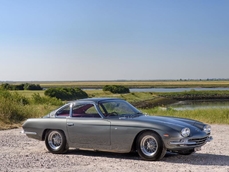Mini Cooper GTS Works Race Car 1966
Allgemeine Beschreibung :
Woodham Mortimer are delighted to offer one of the most iconic Mini Cooper S cars from the 1960’s; the only Factory Works Broadspeed GTS Race Car, originally registered EOP 88D.
The brainchild of Ralph Broad, the Birmingham-born saloon car racer and tuner and produced by his company Broadspeed Engineering. Broad’s career in the automotive industry began at the early age of 14 when he took over the family garage business after the death of his father. Broad was a confident man with a zest for life so it is unsurprising that he took up racing and was one of the pioneers who first saw the competition potential in the new BMC Mini, securing a class win in his maiden Silverstone race with a Mini in 1959. His lap times were fast enough to comprehensively demolish the class lap record and the publicity value of such performance was not lost on Broad who soon offered private Mini customers a full race conversion for £340.
Building on these early successes he established Team Broadspeed in 1962, competing against the factory-backed Mini Coopers in Group 3 of the British Touring Car Championship. While the Broadspeed cars sometimes lacked the straight-line speed of the works cars, their overall handling was deemed superior and as they became more competitive they were able to attract BMC factory support in 1964. By 1965, Broadspeed became the official works team for the BMC Mini Cooper S in the European Saloon Car Championship. The Broadspeed cars won their class at the Monza 4 Hours, Spa and Zandvoort, but despite this success, Broad moved to Ford at the end of 1965 to run a team of Ford Anglias, taking his top driver, John Fitzpatrick, with him for the 1966 season.
While running his team of Broadspeed Anglias, Broad had also gone into small-scale road car production with his Mini Cooper-based Broadspeed GT 2+2. This incredible little car not only looked very different from its Mini parent but featured numerous interior improvements and performance modifications. The most notable difference in its exterior looks from a standard Mini was the new streamlined fibre-glass fastback roof and rear spoiler. Other changes were dependent on the model chosen: for a road car there was the entry level GT, which featured the bodywork changes plus adjustable suspension and steering column; the GT de-luxe which had special seats, thicker carpets, new dash panel and moulded bumpers; and finally the top of the range Super de-luxe which had everything else plus twin fuel tanks, improved lighting, leather covered steering wheel, “Paddy Hopkirk” throttle pedal extension, highly tuned engine, oil-cooler, twin exhausts and competition brakes. The engine tune was particularly noteworthy and involved a modified cylinder head, Broadspeed “Road/Race” camshaft, re-contoured combustion chambers, a 10.5 to 1 compression ratio and a modified inlet manifold carrying two 1 ½ inch H4 S.U.s. .
In addition to the road car there was also a very special GTS racer (this car), which contemporary reports estimated to be capable of 140 mph. This variant was stripped out and significantly lighter than the road going versions and featured lightweight mag-alloy wheels, competition dynamo, undertray, lightweight doors and bonnet, lightened chassis, strengthened sub-frames, fully adjustable front and rear suspension and a fully tuned 1,366cc engine. From the outset the numbers of GTS cars built was to be extremely limited and only available to special customers. In the end only one example was built by Broadspeed as a works racer to be driven by John Fitzpatrick.
The resulting GT and GTS Mini coupe had the appeal of a small-scale Aston Martin and was warmly received with public and press alike. Sadly the production run was curtailed and by the time the factory closed in 1968 (demolished to make way for a ring road) only 28 had been built.
The example offered here is the only works GTS race car built. The race car was campaigned extensively by John Fitzpatrick for Broadspeed, who scored numerous class wins and podium finishes over the 1966 and 1967 seasons at venues as varied as Brands Hatch, Oulton Park, Zandvort and Welschap.
Professionally restored in recent years, this is possibly a once in lifetime opportunity acquire one of the most important Mini derivatives of the 1960s.
Please contact us for further details. UNDER OFFER
https://www.jdclassics.com/Cars/For-Sale/1966-Broadspeed-Mini-GTS-Works-Race-Car/834a6f34-d877-4a67-f576-08d526a380ce
1966 Mini Cooper GTS Works Race Car is listed verkauft on ClassicDigest in Mayfair by JD Classics for Preis nicht verfügbar.
Fakten der Auto
Karosserietyp : Auto Marke : Mini Modell : Cooper Ausführung : GTS Works Race Car Hubraum : 0.0 Modelljahr : 1966 Lage : Maldon
Verkauft
Angaben Zum Verkäufer
Verkauft
People who viewed this Mini Cooper also viewed similar Mini listed at ClassicDigest
Other cars listed for sale by this dealer
über Mini
Der Mini ist zweifellos ein ikonisches Auto, das die Automobilindustrie revolutioniert hat und den Standard für Kompaktwagen gesetzt hat. Hier ist eine kurze Geschichte des Mini, seiner Entwicklung und einiger wichtiger Versionen des klassischen Mini:1. Ursprünge und Entwicklung:
Gründer und Designer: Der Mini wurde von Sir Alec Issigonis, einem britisch-griechischen Automobilingenieur, entworfen.
Einführung: Der Mini wurde 1959 offiziell von der British Motor Corporation (BMC) vorgestellt.
Innovatives Design: Issigonis' Design umfasste einen Quermotor, Frontantrieb und ein kompaktes Layout, das den Innenraum maximieren sollte.
2. Klassische Mini-Modelle:
Mark I (1959–1967):
Mini Cooper (1961): Die leistungsorientierte Cooper-Version, in Zusammenarbeit mit dem Rennlegenden John Cooper entwickelt, wurde eingeführt.
Mark II (1967–1970):
Geringfügige Designänderungen, einschließlich eines neu gestalteten Kühlergrills.
Mark III (1969–2000):
Einführung der Varianten Clubman und Clubman Estate.
Weitere Designaktualisierungen, einschließlich eines abgerundeteren vorderen Kühlergrills.
3. Mini Cooper S:
Leistungsvariante: Der Mini Cooper S, insbesondere die Version Mk I, wurde durch seinen Erfolg bei Rallye-Rennen bekannt und gewann mehrmals die Rallye Monte Carlo.
4. Mini Moke:
Nutzfahrzeug: Der Mini Moke war ein Nutzfahrzeug auf Basis des Mini-Plattformkonzepts mit offenem Verdeck. Er wurde in verschiedenen warmen Regionen populär.
5. Mini Countryman:
Verlängerte Version: Der Mini Countryman wurde als längere und praktischere Version des klassischen Mini eingeführt. Er verfügte über eine rückwärts öffnende Tür für einen leichteren Zugang zu den Rücksitzen.
6. Ende der Produktion:
Spätere Jahre: Die Produktion des klassischen Mini lief bis zum Jahr 2000 weiter.
Abschlusseditionen: Der letzte klassische Mini verließ die Produktionslinie am 4. Oktober 2000 und markierte das Ende einer Ära.
7. BMW-Ära und neuer MINI:
BMW-Übernahme: BMW erwarb die Rechte an der Marke Mini und führte 2001 den neuen MINI ein.
Moderne Interpretation: Der neue MINI behielt einige Designelemente des klassischen Mini bei, verfügte jedoch über moderne Technologie und Sicherheitsstandards.
8. Erbe und Einfluss:
Kulturelles Symbol: Der klassische Mini wurde zu einem kulturellen Symbol, das britisches Design und Effizienz verkörpert.
Einfluss auf Kompaktwagen: Das Layout und die Designprinzipien des Mini beeinflussten die Entwicklung von Kompaktwagen für Jahrzehnte.
Die Auswirkungen des Mini auf die Automobilindustrie gehen über seine kompakte Größe hinaus. Er repräsentiert eine Designphilosophie, die auf Effizienz, Raumnutzung und Fahrspaß setzt. Die anhaltende Beliebtheit des klassischen Mini ist ein Beweis für sein zeitloses Design und innovative Ingenieurskunst.











